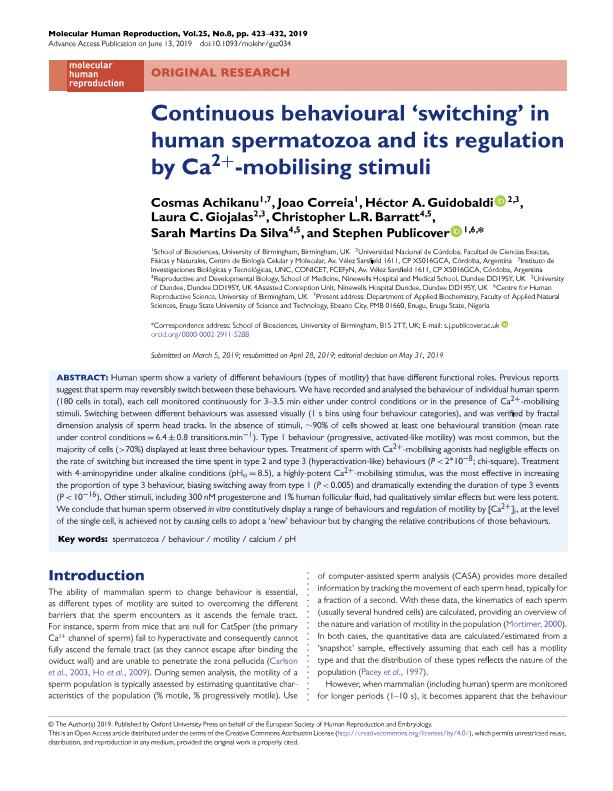Mostrar el registro sencillo del ítem
dc.contributor.author
Achikanu, Cosmas
dc.contributor.author
Correia, Joao
dc.contributor.author
Guidobaldi, Héctor Alejandro

dc.contributor.author
Giojalas, Laura Cecilia

dc.contributor.author
Barratt, Christopher
dc.contributor.author
Da Silva, Sarah Martins
dc.contributor.author
Publicover, Stephen
dc.date.available
2020-03-25T17:31:36Z
dc.date.issued
2019-07-13
dc.identifier.citation
Achikanu, Cosmas; Correia, Joao; Guidobaldi, Héctor Alejandro; Giojalas, Laura Cecilia; Barratt, Christopher; et al.; Continuous behavioural 'switching' in human spermatozoa and its regulation by Ca2+-mobilising stimuli; Oxford University Press; Molecular Human Reproduction; 25; 8; 13-7-2019; 423-432
dc.identifier.issn
1360-9947
dc.identifier.uri
http://hdl.handle.net/11336/100724
dc.description.abstract
Human sperm show a variety of different behaviours (types of motility) that have different functional roles. Previous reports suggest that sperm may reversibly switch between these behaviours. We have recorded and analysed the behaviour of individual human sperm (180 cells in total), each cell monitored continuously for 3-3.5 min either under control conditions or in the presence of Ca2+-mobilising stimuli. Switching between different behaviours was assessed visually (1 s bins using four behaviour categories), and was verified by fractal dimension analysis of sperm head tracks. In the absence of stimuli, ~90% of cells showed at least one behavioural transition (mean rate under control conditions = 6.4 ± 0.8 transitions.min-1). Type 1 behaviour (progressive, activated-like motility) was most common, but the majority of cells (>70%) displayed at least three behaviour types. Treatment of sperm with Ca2+-mobilising agonists had negligible effects on the rate of switching but increased the time spent in type 2 and type 3 (hyperactivation-like) behaviours (P < 2∗10-8; chi-square). Treatment with 4-aminopyridine under alkaline conditions (pHo = 8.5), a highly-potent Ca2+-mobilising stimulus, was the most effective in increasing the proportion of type 3 behaviour, biasing switching away from type 1 (P < 0.005) and dramatically extending the duration of type 3 events (P < 10-16). Other stimuli, including 300 nM progesterone and 1% human follicular fluid, had qualitatively similar effects but were less potent. We conclude that human sperm observed in vitro constitutively display a range of behaviours and regulation of motility by [Ca2+]i, at the level of the single cell, is achieved not by causing cells to adopt a 'new' behaviour but by changing the relative contributions of those behaviours.
dc.format
application/pdf
dc.language.iso
eng
dc.publisher
Oxford University Press

dc.rights
info:eu-repo/semantics/openAccess
dc.rights.uri
https://creativecommons.org/licenses/by/2.5/ar/
dc.subject
BEHAVIOUR
dc.subject
CALCIUM
dc.subject
MOTILITY
dc.subject
PH
dc.subject
SPERMATOZOA
dc.subject.classification
Biología Celular, Microbiología

dc.subject.classification
Ciencias Biológicas

dc.subject.classification
CIENCIAS NATURALES Y EXACTAS

dc.title
Continuous behavioural 'switching' in human spermatozoa and its regulation by Ca2+-mobilising stimuli
dc.type
info:eu-repo/semantics/article
dc.type
info:ar-repo/semantics/artículo
dc.type
info:eu-repo/semantics/publishedVersion
dc.date.updated
2020-01-13T14:36:03Z
dc.identifier.eissn
1460-2407
dc.journal.volume
25
dc.journal.number
8
dc.journal.pagination
423-432
dc.journal.pais
Reino Unido

dc.journal.ciudad
Oxford
dc.description.fil
Fil: Achikanu, Cosmas. University of Birmingham; Reino Unido
dc.description.fil
Fil: Correia, Joao. University of Birmingham; Reino Unido
dc.description.fil
Fil: Guidobaldi, Héctor Alejandro. Consejo Nacional de Investigaciones Científicas y Técnicas. Centro Científico Tecnológico Conicet - Córdoba. Instituto de Investigaciones Biológicas y Tecnológicas. Universidad Nacional de Córdoba. Facultad de Ciencias Exactas, Físicas y Naturales. Instituto de Investigaciones Biológicas y Tecnológicas; Argentina. Universidad Nacional de Córdoba. Facultad de Ciencias Exactas, Físicas y Naturales. Centro de Biología Celular y Molecular; Argentina
dc.description.fil
Fil: Giojalas, Laura Cecilia. Universidad Nacional de Córdoba. Facultad de Ciencias Exactas, Físicas y Naturales. Centro de Biología Celular y Molecular; Argentina. Consejo Nacional de Investigaciones Científicas y Técnicas. Centro Científico Tecnológico Conicet - Córdoba. Instituto de Investigaciones Biológicas y Tecnológicas. Universidad Nacional de Córdoba. Facultad de Ciencias Exactas, Físicas y Naturales. Instituto de Investigaciones Biológicas y Tecnológicas; Argentina
dc.description.fil
Fil: Barratt, Christopher. University of Dundee; Reino Unido
dc.description.fil
Fil: Da Silva, Sarah Martins. University of Dundee; Reino Unido
dc.description.fil
Fil: Publicover, Stephen. University of Birmingham; Reino Unido
dc.journal.title
Molecular Human Reproduction

dc.relation.alternativeid
info:eu-repo/semantics/altIdentifier/doi/http://dx.doi.org/10.1093/molehr/gaz034
dc.relation.alternativeid
info:eu-repo/semantics/altIdentifier/url/https://academic.oup.com/molehr/article/25/8/423/5514444
Archivos asociados
